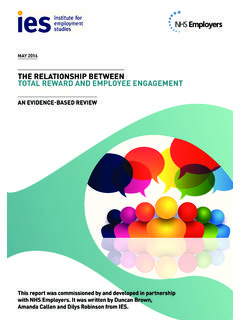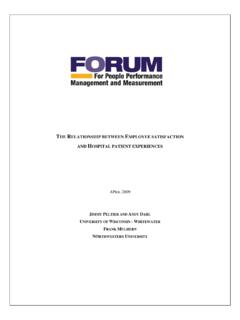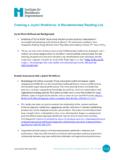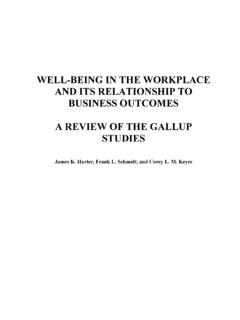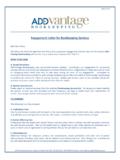Transcription of employee engagement - SIES
1 1 WPS05 employee engagement SIES College of Management Studies Working Paper Series The Working Paper Series would attempt to disseminate the findings of research in specific areas and also to facilitate discussions and sharing of perspectives and information about the identified areas. The papers carry the names of the authors and should be cited accordingly. The views, findings, and interpretations expressed in this paper are entirely those of the authors. They do not represent the views of SIESCOMS and its management. These working papers would be available online at No part of the paper can be reproduced in any form without the prior permission of the author. However, they can be quoted by citing the reference.
2 2 Working Paper 05/07 employee engagement Nitin Vazirani Dean in OB and HR SIES College of Management Studies Nerul Abstract employee engagement is the level of commitment and involvement an employee has towards their organization and its values. An engaged employee is aware of business context, and works with colleagues to improve performance within the job for the benefit of the organization. It is a positive attitude held by the employees towards the organization and its values. The paper focuses on how employee engagement is an antecedent of job involvement and what should company do to make the employees engaged. The paper also looks at the Gallup 12 point questionnaire, twelve-question survey that identifies strong feelings of employee engagement and the steps which shows how to drive an engaged employee .
3 3 Introduction engagement at work was conceptualized by Kahn, (1990) as the harnessing of organizational members selves to their work roles. In engagement , people employ and express themselves physically, cognitively, and emotionally during role performances. The second related construct to engagement in organizational behavior is the notion of flow advanced by Csikszentmihalyi (1975, 1990). Csikzentmihalyi (1975) defines flow as the holistic sensation that, people feel when they act with total involvement. Flow is the state in which there is little distinction between the self and environment. When individuals are in Flow State little conscious control is necessary for their actions. employee engagement is the thus the level of commitment and involvement an employee has towards their organization and its values.
4 An engaged employee is aware of business context, and works with colleagues to improve performance within the job for the benefit of the organization. The organization must work to develop and nurture engagement , which requires a two-way relationship between employer and employee . Thus employee engagement is a barometer that determines the association of a person with the organization engagement is most closely associated with the existing construction of job involvement (Brown 1996) and flow (Csikszentmihalyi, 1990). Job involvement is defined as the degree to which the job situation is central to the person and his or her identity (Lawler & Hall, 1970). Kanungo (1982) maintained that job involvement is a Cognitive or belief state of Psychological identification. Job involvement is thought to depend on both need saliency and the potential of a job to satisfy these needs.
5 Thus job involvement results form a cognitive judgment about the needs satisfying abilities of the job. Jobs in this view are tied to one s self image. engagement differs from job in as it is concerned more with how the individual employees his/her self during the performance of his / her job. Furthermore engagement entails the active use of emotions. Finally engagement may be thought of as an antecedent to job involvement in that individuals who experience deep engagement in their roles should come to identify with their jobs. 4 When Kahn talked about employee engagement he has given important to all three aspects physically, cognitively and emotionally. Whereas in job satisfaction importance has been more given to cognitive side. HR practitioners believe that the engagement challenge has a lot to do with how employee feels about the about work experience and how he or she is treated in the organization.
6 It has a lot to do with emotions which are fundamentally related to drive bottom line success in a company. There will always be people who never give their best efforts no matter how hard HR and line managers try to engage them. But for the most part employees want to commit to companies because doing so satisfies a powerful and a basic need in connect with and contribute to something significant . Aspects of employee engagement Three basic aspects of employee engagement according to the global studies are:- The employees and their own unique psychological make up and experience The employers and their ability to create the conditions that promote employee engagement Interaction between employees at all levels. Thus it is largely the organization s responsibility to create an environment and culture conducive to this partnership, and a win-win equation.
7 Categories of employee engagement According to the Gallup the Consulting organization there are there are different types of people:- Engaged--"Engaged" employees are builders. They want to know the desired expectations for their role so they can meet and exceed them. They're naturally curious about their company and their place in it. They perform at consistently high levels. They want to use their talents and strengths at work every day. They work with passion and they drive innovation and move their organization forward 5 Not Engaged---Not-engaged employees tend to concentrate on tasks rather than the goals and outcomes they are expected to accomplish. They want to be told what to do just so they can do it and say they have finished. They focus on accomplishing tasks vs.
8 Achieving an outcome. Employees who are not-engaged tend to feel their contributions are being overlooked, and their potential is not being tapped. They often feel this way because they don't have productive relationships with their managers or with their coworkers. Actively Disengaged--The "actively disengaged" employees are the "cave dwellers." They're "Consistently against Virtually Everything." They're not just unhappy at work; they're busy acting out their unhappiness. They sow seeds of negativity at every opportunity. Every day, actively disengaged workers undermine what their engaged coworkers accomplish. As workers increasingly rely on each other to generate products and services, the problems and tensions that are fostered by actively disengaged workers can cause great damage to an organization's functioning.
9 Importance of engagement engagement is important for managers to cultivate given that disengagement or alienation is central to the problem of workers lack of commitment and motivation (Aktouf). Meaningless work is often associated with apathy and detachment from ones works (Thomas and Velthouse). In such conditions, individuals are thought to be estranged from their selves (Seeman, 1972) .Other Research using a different resource of engagement (involvement and enthusiasm) has linked it to such variables as employee turnover, customer satisfaction loyalty, safety and to a lesser degree, productivity and profitability criteria (Harter, Schnidt & Hayes, 2002). 6 An organization s capacity to manage employee engagement is closely related to its ability to achieve high performance levels and superior business results.
10 Some of the advantages of Engaged employees are Engaged employees will stay with the company, be an advocate of the company and its products and services, and contribute to bottom line business success. They will normally perform better and are more motivated. There is a significant link between employee engagement and profitability. They form an emotional connection with the company. This impacts their attitude towards the company s clients, and thereby improves customer satisfaction and service levels It builds passion, commitment and alignment with the organization s strategies and goals Increases employees trust in the organization Creates a sense of loyalty in a competitive environment Provides a high-energy working environment Boosts business growth Makes the employees effective brand ambassadors for the company A highly engaged employee will consistently deliver beyond expectations.
